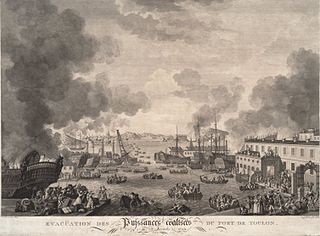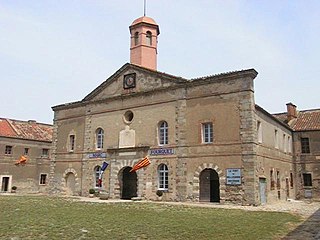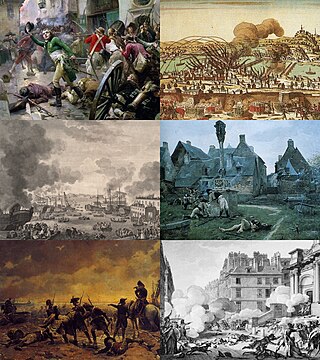
The Committee of Public Safety was a committee of the National Convention which formed the provisional government and war cabinet during the Reign of Terror, a violent phase of the French Revolution. Supplementing the Committee of General Defence, created early January 1793, the Committee of Public Safety was created on 6 April 1793 by the National Convention. It was charged with protecting the new republic against its foreign and domestic enemies, fighting the First Coalition and the Vendée revolt. As a wartime measure, the committee was given broad supervisory and administrative powers over the armed forces, judiciary and legislature, as well as the executive bodies and ministers of the convention.

The Society of the Friends of the Constitution, renamed the Society of the Jacobins, Friends of Freedom and Equality after 1792 and commonly known as the Jacobin Club or simply the Jacobins, was the most influential political club during the French Revolution of 1789. The period of its political ascendancy includes the Reign of Terror, during which well over 10,000 people were put on trial and executed in France, many for political crimes.

The National Convention was the constituent assembly of the Kingdom of France for one day and the French First Republic for its first three years during the French Revolution, following the two-year National Constituent Assembly and the one-year Legislative Assembly. Created after the great insurrection of 10 August 1792, it was the first French government organized as a republic, abandoning the monarchy altogether. The Convention sat as a single-chamber assembly from 20 September 1792 to 26 October 1795.

Georges Auguste Couthon was a French politician and lawyer known for his service as a deputy in the Legislative Assembly during the French Revolution. Couthon was elected to the Committee of Public Safety on 30 May 1793. Along with his close associate Louis Antoine de Saint-Just and Maximilien Robespierre, he formed an unofficial triumvirate within the committee which wielded power during the Reign of Terror until the three were arrested and executed in 1794 during the Thermidorian Reaction. A Freemason, Couthon played an important role in the development of the Law of 22 Prairial, which was responsible for a sharp increase in the number of executions of accused counter-revolutionaries.

The War of the Pyrenees, also known as War of Roussillon or War of the Convention, was the Pyrenean front of the First Coalition's war against the First French Republic. It pitted Revolutionary France against the kingdoms of Spain and Portugal from March 1793 to July 1795 during the French Revolutionary Wars.

The Siege of Paris took place from 19 September 1870 to 28 January 1871 and ended in the capture of the city by forces of the various states of the North German Confederation, led by the Kingdom of Prussia. The siege was the culmination of the Franco-Prussian War, which saw the Second French Empire attempt to reassert its dominance over continental Europe by declaring war on the North German Confederation. The Prussian-dominated North German Confederation had recently emerged victorious in the Austro-Prussian War of 1866, which led to the questioning of France's status as the dominant power of continental Europe. With a declaration of war by the French parliament on 16 July 1870, Imperial France soon faced a series of defeats at German hands over the following months, leading to the Battle of Sedan, which, on 2 September 1870, saw a decisive defeat of French forces and the capture of the French emperor, Napoleon III.

The siege of Toulon was a military engagement that took place during the Federalist revolts and the War of the First Coalition, part of the French Revolutionary Wars. It was undertaken by forces of the French Republic against Royalist rebels supported by Anglo-Spanish forces in the southern French city of Toulon. It was during this siege that young Napoleon Bonaparte first won fame and promotion when his plan, involving the capture of fortifications above the harbour, was credited with forcing the city to capitulate and the Anglo-Spanish fleet to withdraw. The siege marked the first involvement of the British Royal Navy with the French Revolution.

The siege of Bellegarde commenced on 23 May 1793 and ended on 24 June 1793 when Colonel Boisbrulé's French garrison surrendered the Fort de Bellegarde to a Spanish army under the command of Antonio Ricardos. The capture of the fort gave Spain control of an important road through the Pyrenees. The siege took place during the War of the Pyrenees, part of the French Revolutionary Wars. Fort de Bellegarde is on a height overlooking the border town of Le Perthus, which lies on the modern A9 autoroute and Autovía A-7.

Antonio Ricardos Carrillo de Albornoz was a Spanish general. He joined the army of the Kingdom of Spain and fought against Habsburg Austria, the Portugal, and the First French Republic during a long military career. By embracing the Spanish Enlightenment, he earned the displeasure of conservative elements of society. He played an active role in reforming the Spanish military. Upon the outbreak of the War of the Pyrenees in 1793, the king sent him to command in Catalonia. He invaded Roussillon where he won several victories over the French. After his death in early 1794, the war went badly for Spain.
Louis-Charles de La Motte-Ango, vicomte de Flers joined the French Royal army and rose in rank to become a general officer in the French Revolutionary Wars. After serving in the Austrian Netherlands, he was appointed to command the Army of the Eastern Pyrenees. His army suffered several defeats in May and June 1793, but he rallied his troops to win a defensive victory at the Battle of Perpignan in July. The all-powerful Representatives-on-mission arrested him in August 1793 for a minor setback and sent him to Paris under arrest. The Committee of Public Safety executed him by guillotine on trumped up charges in the last days of the Reign of Terror. De Flers is one of the names inscribed under the Arc de Triomphe.

The Federalist revolts were uprisings that broke out in various parts of France in the summer of 1793, during the French Revolution. They were prompted by resentments in France's provincial cities about increasing centralisation of power in Paris, and increasing radicalisation of political authority in the hands of the Jacobins. In most of the country, the trigger for uprising was the exclusion of the Girondins from the National Convention after the Insurrection of 31 May – 2 June 1793. Although they shared common origins and political objectives, the revolts were not centrally organised or well-coordinated. The revolts were put down by the armies of the Convention over the following months. The Reign of Terror was then imposed across France to punish those associated with them and to enforce Jacobin ideology.
The revolt of Lyon against the National Convention was a counter-revolutionary movement in the city of Lyon during the time of the French Revolution. It was a revolt of moderates against the more radical National Convention, the third government during the French Revolution. It broke out in June 1793 and was put down in October of the same year, after government forces had besieged the city.

The Battle of Perpignan or Battle of Niel(fr:Bataille de Perpignan) on 17 July 1793 saw the French Army of the Eastern Pyrenees led by Louis-Charles de Flers defending against an offensive by the Spanish Army of Catalonia commanded by Antonio Ricardos. The French turned back the Spanish attacks and forced their opponents to pull back. Perpignan is now the capital of Pyrénées Orientales department, but in 1793 was the chief city of Roussillon province. The action was fought during the War of the Pyrenees, part of the War of the First Coalition.

The siege of Condé saw a force made up of Habsburg Austrians and French Royalists commanded by Duke Ferdinand Frederick Augustus of Württemberg lay siege to a Republican French garrison led by Jean Nestor de Chancel. After a blockade lasting about three months the French surrendered the fortress. The operation took place during the War of the First Coalition, part of a larger conflict known as the French Revolutionary Wars. Condé-sur-l'Escaut, France is located near the Belgium border about 14 kilometres (9 mi) northeast of Valenciennes.

The invasion of Corsica was a campaign fought in the spring and summer of 1794 by combined British military and Corsican irregular forces against a French garrison, early in the French Revolutionary Wars. The campaign centred on sieges of three principal towns in Northern Corsica; San Fiorenzo, Bastia and Calvi, which were in turn surrounded, besieged and bombarded until by August 1794 French forces had been driven from the island entirely.

The Battle of Epierre was part of a larger War of the First Coalition campaign that pitted a Republican French army led by François Christophe de Kellermann against a numerically stronger Kingdom of Sardinia-Piedmont army commanded by the Prince Maurizio, Duke of Montferrat. Under the overall leadership of the Austrian commander in chief Joseph Nikolaus De Vins, Montferrat launched an offensive in mid-August 1793 to recapture the Duchy of Savoy from the French. Because the French were preoccupied with the Siege of Lyon, the Piedmontese recovered most of the Maurienne and Tarentaise Valleys, but they were stopped just short of Albertville and the reconquest of Savoy. In September, Kellermann launched a counteroffensive in which he adroitly switched his troops between valleys in order to drive back the Piedmontese. At Épierre, the French under Jean-Denis Le Doyen defeated the Marquis of Cordon in a local action. By 8 October the Piedmontese abandoned all their gains and withdrew to the crests of the Graian Alps. In spite of his victory, the suspicious politicians in Paris put Kellermann in arrest and he was imprisoned until November 1794.

The Battle of Collioure saw troops from Spain attack a French division during the War of the Pyrenees. The Spanish troops led by Gregorio García de la Cuesta were completely successful in ousting the French under Louis Pierre François Delattre from Collioure, Fort Saint-Elme and Port-Vendres. The contending sides were the Spanish Army of Catalonia commanded by Antonio Ricardos and the French Army of the Eastern Pyrenees led by François Amédée Doppet and Eustache Charles d'Aoust. In September 1793, the French successfully defended Perpignan from Spanish attack but December saw a series of French defeats. One of the French representatives on mission, Claude Dominique Côme Fabre was killed during the fighting at Collioure. Aoust and Delattre were arrested, condemned and executed by guillotine for the disaster.

The siege of Collioure saw a Republican French army led by Jacques François Dugommier invest the French port of Collioure held by a Spanish garrison commanded by Eugenio Navarro. The actual siege work was carried out by Pierre François Sauret's reinforced division. After the three-and-a-half-week War of the Pyrenees siege, the Spanish fleet sent to evacuate the garrison was blown off station by a storm. Navarro surrendered the town on the promise to exchange the paroled garrison for an equal number of French prisoners. After the defenders were released, the Spanish army commander Luis Fermín de Carvajal, Conde de la Unión refused to authorize the agreement or return any French captives. The infuriated French government afterward passed a decree ordering death to all Spanish prisoners and some units carried out the brutal order.

Louis François Perrin, comte de Précy, was a French nobleman and soldier who lead royalist forces during the Siege of Lyon.

André de La Barre was born in New France and joined France's colonial forces at a very young age. In 1764, he trained as an artillerist, but transferred to a cavalry unit as a volunteer three years later. In 1772 he officially joined the French Royal Army as a sous lieutenant of dragoons. In 1779, he was wounded at Savannah in the American Revolutionary War. By 1788, he was a staff officer with the rank of major. The start of the War of the First Coalition allowed officers chances for rapid advancement. Named a general of brigade in August 1793, La Barre fought at Toulon that year. Going to the Army of the Eastern Pyrenees, he distinguished himself at Boulou in May 1794. He was killed leading his cavalrymen in action at La Junquera on 7 June 1794.



















